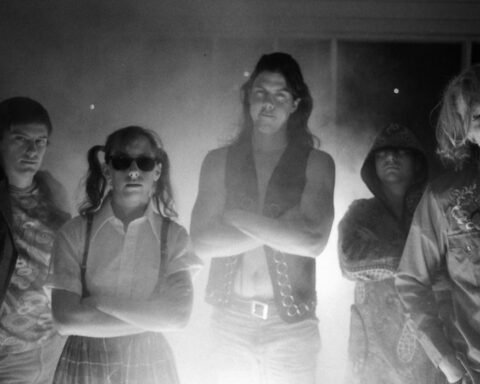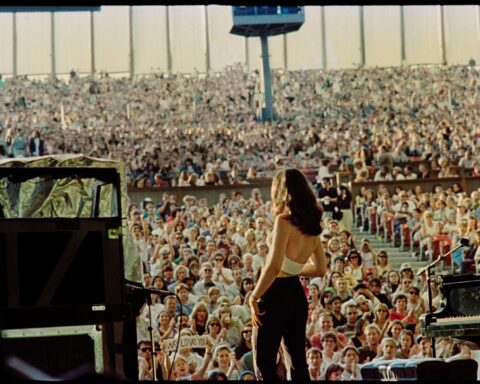Amazing Grace
(USA, 87 min.)
Directed by Sydney Pollack and “realized” by Alan Elliot
I’ve caught myself a few times over the past week calling Amazing Grace an archival film. “It’s great, but as far as archival films lately, it’s no Apollo 11,” the cocktail hour one-liner goes.
Amazing Grace might not truly be an archival film since it brings to the screen unique 16mm footage shot by late director Sydney Pollack of a series of concerts performed by the late Aretha Franklin in 1972. Like the moon landing and behind the scenes action of Apollo 11, the doc provides a one-of-a-kind view for audiences. This intimate big screen gospel concert is arguably the next best thing to seeing the Queen of Soul in person.
Amazing Grace feels like an archival film because it unearths rare and extraordinary footage that many people never thought they would see. Long-delayed due to technical issues involving sound synchronization, legal troubles, and Franklin’s insistence that the movie never see the light of day, including much-publicized snafus when the doc was pulled from both the Telluride and Toronto International Film Festivals at the 11th hour in 2015 due to the doc’s use of her likeness, the film has finally been assembled and calibrated to perfection. Amazing Grace was worth the wait.
Amazing Grace is essentially a vintage concert doc as it features wall-to-wall music that’s as thick and groovy as shag carpeting. Amazing Grace offers footage shot over two nights at Los Angeles’ New Temple Missionary Baptist Church where Franklin performed two concerts of gospel tunes for the live recording of her album Amazing Grace. There’s barely any set-up for the concert aside from a title card or two and images of the audience shuffling into their seats. (Surprisingly, Franklin doesn’t even to a full house on the first night!) The Queen of Soul receives a brief introduction from Reverend James Cleveland, who offers some direction to the audience and explaining how things go with a live recording, and providing advice about being energetic and ensuring they bring their “Amens!” to every track no matter how many takes Franklin needs.
Franklin is a force of nature when she takes the stage. Singing mostly hymns that inspired her while growing up in her father’s church, Franklin’s set list serves as a nice slice of biography. Without talking heads, Amazing Grace provides a profound sense of who Franklin was and where she came from simply by engaging the audience through the power of song. Her soulful performances, accompanied by a sweaty Reverend Cleveland on the piano and the Southern California Community Choir on background vocals, speak to her roots and to the role of the church community in shaping voices as the faithful congregate every Sunday. One could go through and unpack each song, but the title track is undoubtedly the highlight in a uniformly great performance. Electrifying and transformative, Franklin’s vocals provide a truly religious experience: it’s a rare 90-minute feat that makes being at church enjoyable.
Franklin barely acknowledges the crowds who come out to see her both nights, including her father C.L. Franklin, gospel singer Clara Ward, and rocker Mick Jagger, but Amazing Grace livens up the concert formula by nodding to the filmmaking process. The doc frequently breaks the fourth wall as one can see Pollack directing the cinematographers from the wings, pestering them to get in closer to catch the beads of sweat pouring from Franklin and Cleveland, while the occasional bit of split-screen highlights the Queen of Soul and the audience transfixed by her performance.
Where many concert docs are often seamless, the extensive 16mm coverage of the film lets audiences see the many cameras capturing the event. Despite the range of coverage, the footage is aesthetically unremarkable, which adds to the old archival feel, even though the action it captures is consistently great. The sound design and mix is especially notable given its credit for delaying the release, and must have been an astonishingly difficult task to master given that Pollock recorded the whole thing without a clapper. The dedication of the doc’s creative and technical team is most impressive.
The notoriety of the film’s four-decade delay inevitably permeates the film, but it’s impossible to discern any understanding of why Franklin didn’t want audiences to see Amazing Grace. Her vocals are top notch and she gives a showstopping performance that humanizes her by showing she hadn’t lost her roots despite becoming a major star. The film’s a testament to Franklin, an outstanding talent that defined a generation.
Amazing Grace opens in theatres beginning April 12.
.











